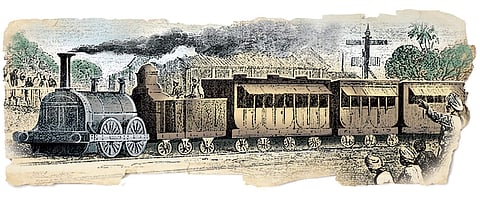

CHENNAI: On this day, 165 years ago, as cheer, joy and applause filled the air amid 21-gun salute, India’s first train with 14 railway carriages and 400 passengers chugged out of Bori Bunder (today’s Chhatrapati Shivaji Terminus) to Thannah (today’s Thane) in 1853. While it was the first commercial passenger service, it was not the first train in the country. If one had to unearth the original reports submitted by the British civil engineers, one would find that the British owed the origins and inception of railways to the Madras Presidency.
Established 16 years before the railway line in Mumbai, in 1836, the first rail road was set up from Chintadripet or Chinna Thari Pettai to Little Mount. Called as the Red-Hills Rail Road, this rail line was more than just an experimental design. The three-mile line originated at Red Hills (northern part of Madras) to the stone quarries around the Little Mount area, along the banks of the river Adyar — originating in Chembarambakkam Lake in Kanchipuram district and winding through Chennai.
On November 11, 1973, a report titled ‘Madras Breakwater’ by Captain Civil Engineer Arthur T Cotton was published in the Reports, correspondence, original papers on various professional subjects connected with the duties of Corps of Engineers- Madras Presidency. The rail road was established to transport granite to build roads in the Madras Presidency and cut down the expenses incurred by transportation through the Adyar river and the common roads. It was a freight railway, but passengers also travelled on it. While there were two to three locomotives with steam engines, animals were used to draw the rail carts, and prison inmates were employed to load and unload the granite.
Cotton, in his report, says, “If the stone is bore by prisoners and conveyed by the Railroad and Canal to the North East angle of Black Town, the cost will be diminished to at least Re. 1 per ton. Had the granite been still brought by the Adyar river, the actual results showed that it would have cost between Rs. 3-4 per ton, when deposited on the work.
Cotton’s reference to Black Town is a derogatory term for the township and the residents of Fort St. George. In his report, Cotton further explains “On the Red Hills Rail Road, one bullock drew 9 common bandy loads of stone, or as much as what 18 bullocks draw on the common roads.” He adds, “The line between Covelong (today’s Kovalam) and Adyar consists of the greater part of Backwater, and all the rest is low sandy soil, so that a canal to that river similar to that leading from North Madras could be completed at a very moderate expense; from Adyar to the beach, probably a rail road would be the best kind of communication. To complete these works would cost scarcely cost Rs. 1.5 lakhs and they would form so valuable a work for general purposes.” However, the rail line was dismantled in 1845 only to make more developments in the railways.
Did you know?